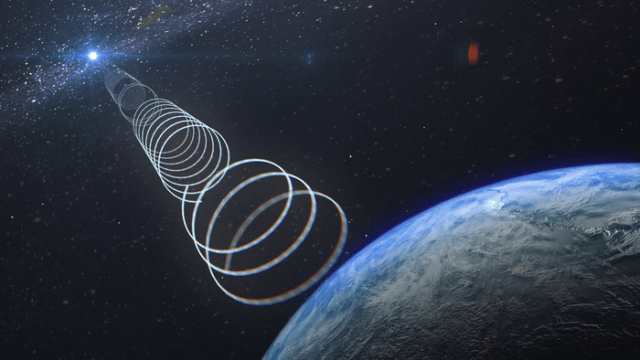Over the course of 2020, astronomers in Australia detected a mysterious batch of radio waves coming from somewhere near the centre of the galaxy. But when the team trained a more sensitive instrument toward the source, they saw it only once more before it disappeared, behaving differently than it had before. The signal is described in a paper published today in the Astrophysical Journal.
“The strangest property of this new signal is that it has a very high polarisation. This means its light oscillates in only one direction, but that direction rotates with time,” said Ziteng Wang, an astrophysicist at the University of Sydney and the lead author of the new study, in a university press release. In other words, the radio waves were intermittently corkscrewing to Earth, without any rhyme or reason. And since they were detected, the trail’s gone cold.
The signal was discovered using the Australian Square Kilometre Array Pathfinder Variables and Slow Transients (ASKAP VAST) Survey, a radio telescope based in extremely remote Western Australia. The mystery object that produced the signal was named ASKAP J173608.2-321635, for the telescope that found it and its coordinates in the sky.
“This object was unique in that it started out invisible, became bright, faded away and then reappeared. This behaviour was extraordinary,” said Tara Murphy, also an astrophysicist at the University of Sydney and a co-author of the paper, in the same release.
When the radio source went dark, the team checked the visible light spectrum, finding nothing. They also turned to a different radio telescope, which yielded a similar amount of nothing. But then, using the MeerKAT radio telescope in South Africa, the team at last spotted the object again, but it disappeared within a day. The researchers haven’t seen it since.

“As for why a source would stop emitting, it could be something related to instabilities in the magnetic field. Magnetic fields can get tangled up and then release energy in bursts,” said David Kaplan, a co-author of the paper and an astrophysicist at the University of Wisconsin-Milwaukee, in an email to Gizmodo. “This happens with our Sun, with magnetars, and with other sorts of objects. So it’s not so much that it stopped emitting, as it only emits sporadically (most of the time it’s off).”
The researchers have a few ideas for what the radio source could’ve been, but they aren’t sure about any of them. The radio wave pattern bears similarities to a class of objects called Galactic Centre Radio Transients, though it also has some differences. Galactic Centre Radio Transients are not one specific object but rather a group of radio-emitting objects around the Milky Way’s centre that don’t have a certain identity.
Because of the characteristics of its burst, the team thought at first that ASKAP J173608.2-321635 might be a pulsar — a spinning dead star whose brightness regularly varies to observers on Earth. But this object’s brightness fluctuations weren’t regular, and its lack of other electromagnetic waves meant it didn’t resemble a small brown dwarf star or a highly magnetic magnetar. It may have been an “oddball” pulsar, Kaplan said, but the team won’t know for sure with their current data.
Even if ASKAP J173608.2-321635 isn’t seen again, they hope that future observations will determine if the object was the rule or the exception — that is, whether the source is the first of a hitherto-unobserved class of objects or something else.
Instead of leapfrogging from radio telescope to radio telescope in the future, the team hopes to use the Square Kilometre Array, the world’s largest radio telescope with 130,000 antennas, for its future observations of distant radio sources. The array is expected to start routine science observations toward the end of this decade.
More: New South African Telescope Releases Epic Image of the Galactic Centre
Editor’s Note: Release dates within this article are based in the U.S., but will be updated with local Australian dates as soon as we know more.
